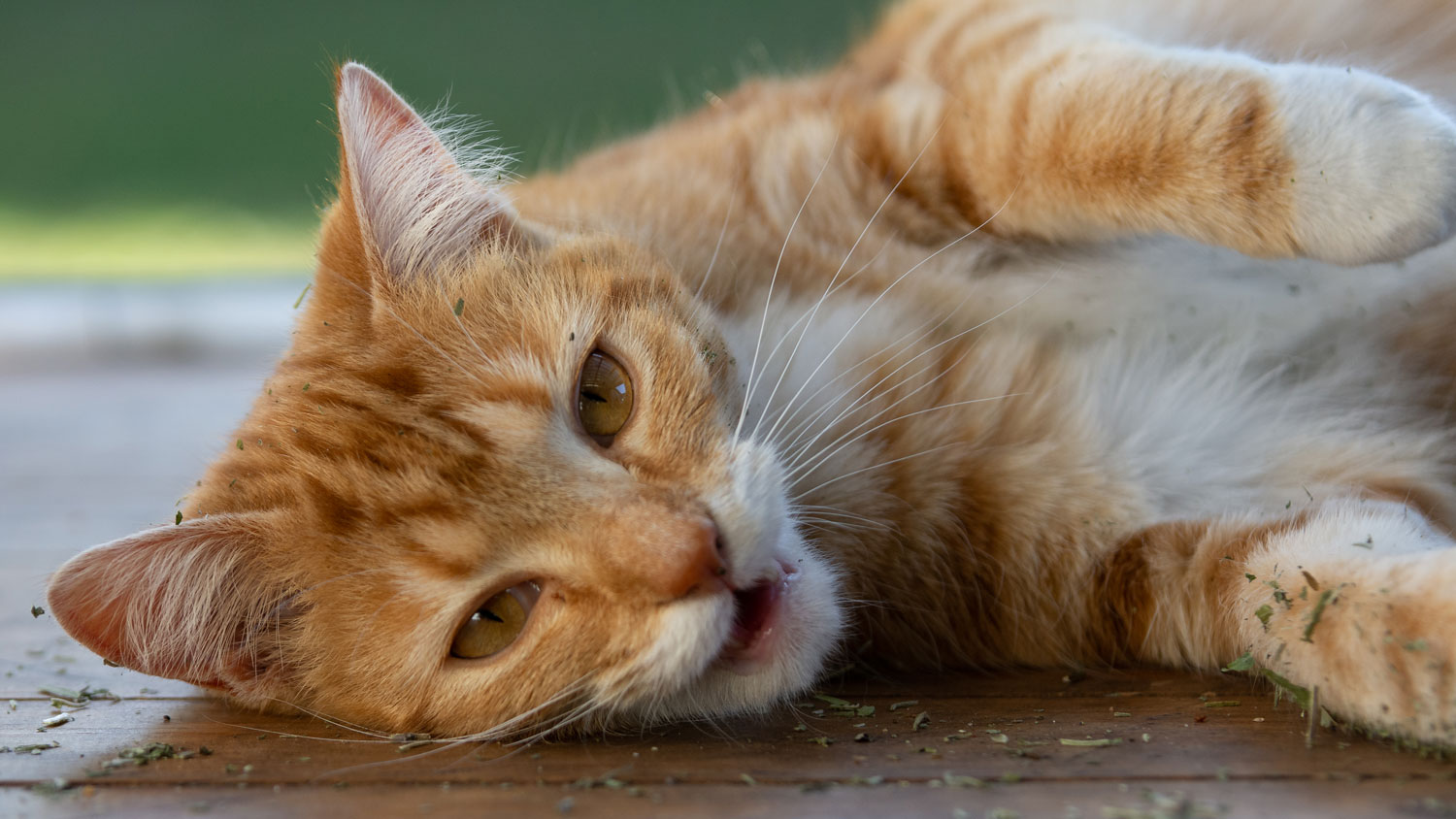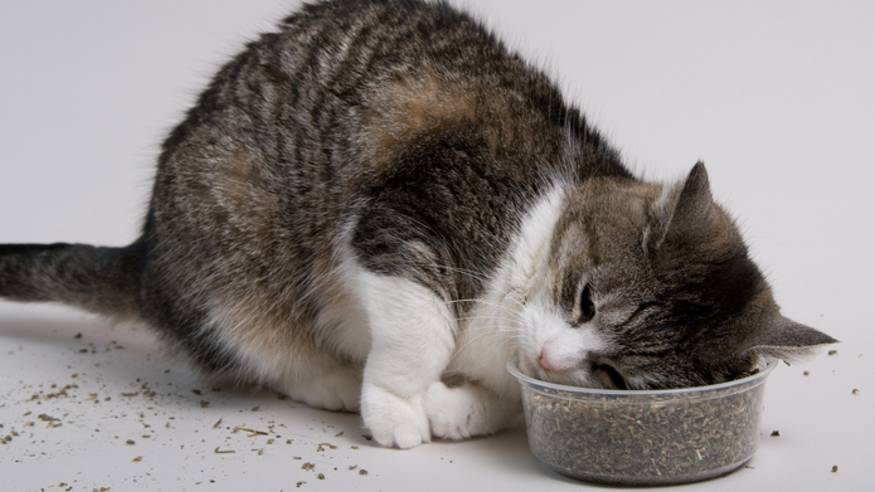Six creative ways to use catnip
Curious about catnip? Read on to find out more unique uses for this popular plant

There’s nothing funnier than watching your cat rolling around and being loopy, and using the best catnip toys provides your feline friend with a whole lot of entertainment. In fact, if you've ever found yourself asking the question 'what does catnip do to cats?', simply observing them after you've dished some up will give you a pretty good idea!
A herb from the mint family, catnip contains an ingredient known as nepetalactone, which can act as both a stimulant and a sedative for cats. This unusual reaction isn’t recorded in any other species — but cats are just crazy about it!
It gets even better though, because not only can you sprinkle some catnip near your cat to give them a bit of fun, it can also be used in several different ways as all the best cat treats can be, and with unique benefits.
This special plant doesn’t tend to have an effect on kittens, and some cats are entirely indifferent to it. For those that react to it though, catnip can be used in a variety of ways to support your cat’s wellbeing and enrichment. Let’s take a look at six creative uses for catnip — number four might surprise you!

Nicky is passionate about cats and is Cats Protection’s Behaviour Manager, promoting feline behaviour and welfare. She holds a BSc (Hons) degree in Animal Behaviour and a Postgraduate Diploma in Companion Animal Behaviour Counselling. Nicky is a registered veterinary nurse. She represents Cats Protection on the Animal Behaviour and Training Council, and has a Cats Protection cat named Kaeto.
1. Introducing new things
The term ‘scaredy cat’ exists for a reason — cats are known to be nervous about new things, places, and experiences. If you’re struggling to acclimate your four-legged friend to something new, you can use catnip to make introductions run smoother.
Whether you’re introducing another cat, person, or object into your cat’s space, simply sprinkle or spray catnip on the object, or around where the new animal or human will be. As a relaxing substance for your kitty, the catnip will keep them calm while they get used to something new. Using catnip in this manner encourages play with their new friend or thing which creates and reinforces positive associations.
2. Feline tea party
The thought of your cat drinking a nice cup of tea might sound a bit unusual, but brewing some catnip tea for your moggy is a surefire tactic to keep them happy and hydrated.
Catnip tea is a refreshing treat for your pet (and humans can drink it too — so you might consider pulling up a chair and enjoying a relaxing tea break together!) Any tea connoisseur will tell you that nothing beats a fresh brew, so why not treat your cat to that experience? As well as providing your cat with a fun new way to enjoy their favorite treat, catnip tea has the added benefit of making some cats more interested in their water.
Get the best advice, tips and top tech for your beloved Pets
This can be a helpful way of avoiding dehydration in cats by encouraging your feline friend to drink more, particularly in the summer months when the weather is warmer and fluid requirements are higher. You can use either fresh leaves or dried catnip, and steep the herb in hot water. This should then be left to cool down, you don’t want to scald your furry friend.
3. Tips for training
It’s no secret that cats are harder to train than dogs, but if you are experiencing behavioral issues with your cat, catnip can be a useful tool to redirect unwanted behaviors and calm feline anxiety.
One such use for this is scenting your cat’s scratching post to encourage them to use it, instead of scratching at your furniture. “While we’re all familiar with cats rolling around with catnip toys, there are some other ways in which it can be helpful,” Nicky Trevorrow, renowned UK-based cat behaviorist explained.
“Firstly, it can be useful when trying to encourage a cat to use a scratch post. For this, I prefer to use leaves from the cat mint plant (Nepeta cataria) as it’s easier to use on the post. Simply break apart a couple of the leaves to release the scent and carefully rub it on the post.”
Nicky stressed the importance of consulting a behaviorist for continuing behavior issues, “It can also be a good stress reliever so may be part of a behavioral modification programme for cats with behavioral issues. In this instance, it should be used following the advice of a qualified behaviorist, as it may not be suitable for some cats or circumstances.”
4. Ward off bug bites
With summer rapidly approaching, you’re probably bracing yourself for the onslaught of mosquitos, ticks and gnats that comes along with the warmer weather. As most cat owners know, it’s not just humans who have to deal with this. Cats, especially outdoor cats, are also susceptible to insect bites and are particularly prone to being bitten by ticks as they lounge in long grass, squeeze under hedges, and weave through farmer’s fields. Tick bites are uncomfortable for your pet and irritating to remove, but difficult to avoid.
This is one of the lesser known benefits of catnip, it acts as an insect repellent. That’s right, this infamous herb doesn’t just make your cat go crazy — it also helps to protect them from bug bites! Catnip has been used as a natural insect repellent for centuries, though with the many options available to us now, not many people realize how effective it can be.
To keep those pesky insects away, plant some catnip in your garden. You could place a few pots of catnip around your house and outdoor area, giving your cat plenty of opportunity to interact with it and reap the insect-repelling benefits. A recent study in Cell Press revealed that when cats chew or damage the plant, it releases a greater amount of the repellent, so using fresh catnip is the best way to keep mosquitos and ticks at bay.
However, while catnip can be effective as an insect repellant we always recommend protecting your kitty against pesky parasites by regularly using one of the best flea treatments for cats.

5. Get cooking
We usually think of giving our cats catnip on its own in either a dried or fresh form, but there are plenty of cool recipes that you can whip up for your feline family member involving catnip that add a little extra excitement to the experience.
Though treats should be given in moderation, some homemade biscuit treats, like these tasty carrot and catnip ones from our DIY cat treats guide, are a creative way for your cat to enjoy the plant. When ingested instead of sniffed, catnip can have a sedative effect. A delicious catnip treat can work wonders on a stressed-out moggy.
6. Easy travels
If your cat is anything like mine, car journeys are a decidedly not fun experience. From a short trip to the vet to a cross-country move, not many cats enjoy being in the car. To make the journey a little more bearable for your cat, consider using catnip spray or sprinkling catnip in their carrier to put them at ease, and provide a fun distraction from the unfamiliar space.
We’ll leave you with a great piece of advice from Nicky, “Catnip only seems to affect about 70-80% of cats, so it’s first worth finding out if your cat is a responder. Always use good quality, organic catnip that’s been grown without pesticides.”
You might also be wondering, 'What is silver vine?' or 'is catnip bad for cats?' If your cat doesn't like catnip, we recommend learning about valerian for cats.

After graduating from the University of East Anglia in 2021, Caitlin started her career in veterinary and pet care journalism at Vision Media, working as a staff writer at MRCVSOnline and regularly contributing to PetFocus Magazine. Armed with a lifelong adoration of cats and a passion for improving the standards of care for small pets, Caitlin took the leap into full-time freelancing in early 2023.
Having spent her career thus far writing content for veterinary clinics, covering veterinary congresses and publishing the latest developments in veterinary medicine. With her love for animals, and interest in all things veterinary, Caitlin is keen to educate on and advocate for the best possible standards of pet care.
When she’s not writing pet care articles, Caitlin enjoys spending time with her massive ginger cat named Jake, and rescue hamster named Coffee. She is also a keen poet, and loves petting every cat she sees when out and about.
